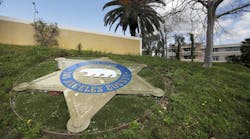Tulsa police are on track to recover more than 300 meth labs this year, a number significantly lower than 2011's but still a concern for law enforcement.
Tulsa police had responded to 274 discarded meth labs this year through Nov. 25, the majority of which were one-pot, or "shake-and-bake," labs. In all of 2011, police cleaned up 429 labs.
"If I'm working 300 meth labs a year, it's still a problem," said Cpl. Mike Griffin, who works in the Tulsa Police Department's Special Investigation Division unit that responds to reported labs. "There's no shortage of people out there selling it or using."
In 2010, 323 labs were reported, and in 2009 there were 315 labs, which is near where Griffin said he expects 2012 to end up.
The majority of the labs discovered were dumped or discarded without much suspect information. In 11 reported labs, a fire was associated with the discovery. Children were found at the site of 10 discovered labs, according to police data.
Some ZIP codes in Tulsa did not report a single meth lab this year. That was not the case in 2011, when every part of the city had at least one lab reported.
The ZIP code with the most labs was again between Interstate 244 and 46th Street North and between Utica and Harvard avenues. Fifty-nine labs were recovered there this year, which is down from 80 last year.
In 2007, 148 labs were found across the state of Oklahoma. The relative ease and portability of the shake-and-bake method, centered around northeast Oklahoma, lead to an explosion of labs in 2008.
Legislative efforts
Lawmakers and law enforcement have tried to come up with legislation that curbs the problem by restricting the ability to purchase pseudoephedrine -- the key ingredient needed in the one-pot labs.
The most recent law, which went into effect in July, placed further restrictions on how much pseudoephedrine a person can buy at one time, in a month and every year. The new law will also connect the Oklahoma meth registry to one containing 21 other states to prevent buyers from crossing state lines. That part will be active in January, according to the Oklahoma Bureau of Narcotics and Dangerous Drugs.
The biggest advantage the state could see from the new restrictions is limiting the yearly sale to 60 grams, down from 108, Griffin said.
But to say the reduction in labs is tied to the new law is premature.
"If the law has any kind of pertinent effect, we'll just have to wait and see," said Tulsa County District Attorney Tim Harris, who strongly advocated a ban on over-the-counter pseudoephedrine sales in the state during the last legislative session.
Harris also said his office's no-tolerance policy for meth cooks has taken many of them off the street. His office has filed charges against 190 people who are alleged to have produced or attempted to produce methamphetamine, according to data from the DA's office.
"I don't care what the reason is," Harris said. "I'm just glad there's a decrease."
Meth lab discoveries have been in decline across the state since before the 2012 law went into effect, said Mark Woodward, spokesman for the Oklahoma Bureau of Narcotics and Dangerous Drugs Control. That leads him to say that some of the legislation passed in previous years has had a positive effect.
"We were approaching levels back to our historic pseudo law in 2004," Woodward said. "But, still, one meth lab is too many."
Woodward said 439 labs had been reported in the state as of Nov. 1, compared with 732 as of Nov. 1, 2011.
Meth is still a problem for the rest of the state, but most of that supply comes from Mexico and other southern manufacturing places, Woodward said.
The numbers from law enforcement represent meth labs reported to and cleaned up by authorities, Woodward said. More labs will be found and reported in the population centers of Tulsa than in rural areas, he said.
Production of the drug is centered around northeast Oklahoma, he said.
Looking ahead
While Harris pushed to make pseudoephedrine only available by prescription during the last legislative session, he said he and the Legislature will take a wait-and-see approach to determine what effect the new law will have before launching new restriction efforts. But he said he will continue a broader fight against meth.
"I'm not going to leave this alone because I don't want Tulsa to be the meth capital of Oklahoma," Harris said. "It is the scourge."
Woodward said the bureau was optimistic that aspects of several recent laws will show further success in slowing the meth crisis.
"We're interested in seeing how these measures work before we move to anything tighter," Woodward said.
But dealing with labs and producers nearly every day, Griffin said it will take more than just restrictions on pseudoephedrine to see significant changes.
"If we want meth labs to go away, you have to make pseudo go away," Griffin said. "People can have their choice -- you can't have both."
Copyright 2012 - Tulsa World, Okla.
McClatchy-Tribune News Service


